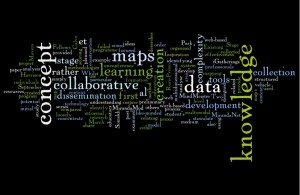Collaborative Knowledge Construction and Concept Maps
This paper describes the development of methodologies for using multidimensional concept mapping as a data collection method, and as a medium to stimulate the creation and dissemination of collaborative knowledge. These concept maps were collected during an initial series of iGatherings organised by MirandaNet Fellows . in the context of work-based learning for education professionals. The first stage of this programme was designed on the MirandaMod model , an informal, loosely structured unconference of like-minded educators to share ideas about the use of technology to inspire others.
This first stage of the research project aimed to
• develop a scoring system for collaborative multimodal concept maps relating to an analysis of the potential effectiveness for identifying concept development and the formation of praxis .
• post preliminary resources on the web as an example of the knowledge creation planned for Stage Two from September to March 2010.
The web-based program MindMeister and Inspiration were compared as the vehicle for this study for the creation and dissemination of knowledge, rather than simply for data collection.
Existing tools that have been used to analyse concept maps have either focused on a map’s content in order to identify the level of a student’s understanding of a particular area of knowledge (Ruiz-Primo, 2000; Park & Calvo, 2008), or have examined the complexity of the map itself (Mavers, Somekh et al., 2002, Harrison et al, 2002). Whilst these tools provided data about the complexity of the maps that had been created, they failed to provide data that related to the process of knowledge construction. They also concentrate on the learning of individuals rather than on collaborative learning.
